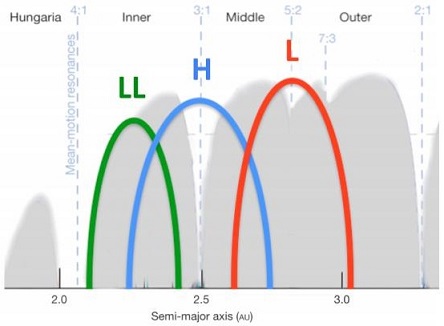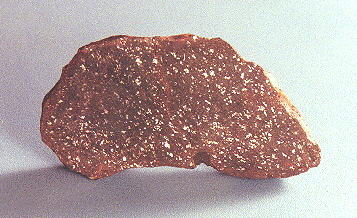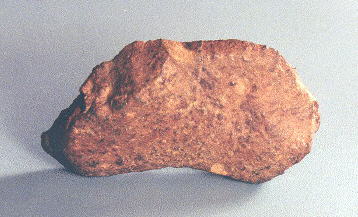Abbott
H3–6
Found 1951
36° 18′ N., 104° 17′ W. This meteoriteWork in progress. A solid natural object reaching a planet’s surface from interplanetary space. Solid portion of a meteoroid that survives its fall to Earth, or some other body. Meteorites are classified as stony meteorites, iron meteorites, and stony-iron meteorites. These groups are further divided according to their mineralogy and Click on Term to Read More was found in Colfax County, New Mexico and was classified (The Meteoritical Bulletin #37) as an H3–6 polymict regolithMixture of unconsolidated rocky fragments, soil, dust and other fine granular particles blanketing the surface of a body lacking an atmosphere. Regolith is the product of "gardening" by repeated meteorite impacts, and thermal processes (such as repeated heating and cooling cycles). Click on Term to Read More brecciaWork in Progress ... A rock that is a mechanical mixture of different minerals and/or rock fragments (clasts). A breccia may also be distinguished by the origin of its clasts: (monomict breccia: monogenetic or monolithologic, and polymict breccia: polygenetic or polylithologic). The proportions of these fragments within the unbrecciated material Click on Term to Read More, which contains impact-melt and shock-darkened clasts embedded within a solar gas-rich matrixFine grained primary and silicate-rich material in chondrites that surrounds chondrules, refractory inclusions (like CAIs), breccia clasts and other constituents. Click on Term to Read More. It has a total known weight of 9.5 kg. Abbott has been shocked to stage S3 as evidenced by olivineGroup of silicate minerals, (Mg,Fe)2SiO4, with the compositional endpoints of forsterite (Mg2SiO4) and fayalite (Fe2SiO4). Olivine is commonly found in all chondrites within both the matrix and chondrules, achondrites including most primitive achondrites and some evolved achondrites, in pallasites as large yellow-green crystals (brown when terrestrialized), in the silicate portion Click on Term to Read More grains with undulose extinctionIn astronomy, the dimming of starlight as it passes through the interstellar medium. Dust scatters some of the light, causing the total intensity of the light to diminish. It is important to take this effect into account when measuring the apparent brightness of stars. The dark bands running across portions Click on Term to Read More and planar fractures. Similarly shocked, hydrated, dark inclusions with CM-like mineralogy and petrologyScience dealing with the origin, history, occurrence, chemical composition, structure and classification of rocks. Click on Term to Read More have been identified in Abbott. These are thought to have accreted at low velocities with low shock and minimal heating prior to the S3 shock event (Rubin and Bottke, 2007, 2009).
One of these CM inclusions, identified as subtype of 2.3 (±0.1), contains chondrulesRoughly spherical aggregate of coarse crystals formed from the rapid cooling and solidification of a melt at ~1400 ° C. Large numbers of chondrules are found in all chondrites except for the CI group of carbonaceous chondrites. Chondrules are typically 0.5-2 mm in diameter and are usually composed of olivine Click on Term to Read More, CAIsSub-millimeter to centimeter-sized amorphous objects found typically in carbonaceous chondrites and ranging in color from white to greyish white and even light pink. CAIs have occasionally been found in ordinary chondrites, such as the L3.00 chondrite, NWA 8276 (Sara Russell, 2016). CAIs are also known as refractory inclusions since they Click on Term to Read More, and ~35 vol% ‘pooly characterized phases’ (PCP)—now determined to be tochilinite-cronstedtite intergrowths (TCI). Another CM inclusionFragment of foreign (xeno-) material enclosed within the primary matrix of a rock or meteorite. Click on Term to Read More, with a subtype of 2.1, has a yellow-green color and contains abundant cm-sized chondrules and phyllosilicatesClass of hydroxyl-bearing silicate minerals with a sheet-like structure. They result from aqueous alteration are dominantly serpentine and smectite in meteorites; found in the matrixes of carbonaceous chondrites. Phyllosilicates consist of repeating sequences of sheets of linked tetrahedra (T) and sheets of linked octahedra (O). The T sheet consists of Click on Term to Read More, with ~30 vol% PCP, along with various sulfides, and carbonates. Anomalies present in some clasts have been attributed to impact heating/dehydration effects.
Prior interest in asteroid 6 Hebe as the source of H chondritesChondrites are the most common meteorites accounting for ~84% of falls. Chondrites are comprised mostly of Fe- and Mg-bearing silicate minerals (found in both chondrules and fine grained matrix), reduced Fe/Ni metal (found in various states like large blebs, small grains and/or even chondrule rims), and various refractory inclusions (such Click on Term to Read More to Earth has lost favor after hydrocode model data showed inconsistencies between expected and observed CRE ages based on the scenario of direct injection into resonances. The steady delivery of H chondriteOrdinary chondrites with a high content of free Ni-Fe metal (15-19 vol. %) and attracted easily to a magnet. Their main minerals are olivine (Fa16-20) and the orthopyroxene bronzite (Fs14.5-18.5), earning them their older name of bronzite chondrites. Chondrules average ~0.3 mm in diameter. Comparison of the reflectance spectra of Click on Term to Read More material from 6 Hebe to Earth is also unexplained. Current studies by Rubin and Bottke (2009) have led to the conclusion that family-forming events resulting in large meteoroidSmall rocky or metallic object in orbit around the Sun (or another star). reservoirs, which have homogenous compositions and locations near dynamical resonances such as the Jupiter 3:1 mean motion resonance at 2.50 AUThe astronomical unit for length is described as the "mean" distance (average of aphelion and perihelion distances) between the Earth and the Sun. Though most references state the value for 1 AU to be approximately 150 million kilometers, the currently accepted precise value for the AU is 149,597,870.66 km. The Click on Term to Read More, are the likely source of the most prevalent falls including H chondrites and HED achondrites (especially howardites). In fact, a number of asteroids having H-like mineralogies have been observed near the 3:1 and the 5:2 resonances, the latter located at ~2.82 AU (Burbine et al., 2015 and references therein). Spectral comparisons conducted on the H chondriteChondrites are the most common meteorites accounting for ~84% of falls. Chondrites are comprised mostly of Fe- and Mg-bearing silicate minerals (found in both chondrules and fine grained matrix), reduced Fe/Ni metal (found in various states like large blebs, small grains and/or even chondrule rims), and various refractory inclusions (such Click on Term to Read More Fayetteville and the asteroid 1270 Datura, a member of a young family less affected by space weathering processes, indicate close similarities exist between them (Mothé-Diniz and Nesvorný, 2008). Based on spectrographic and mineralogical data for more than 1,000 near-Earth asteroids, Binzel et al. (2016) determined the probable main beltBelt located between 2.12 and 3.3 AU from the Sun and located between the orbits of Mars and Jupiter containing the vast majority of asteroids. The asteroid belt is also termed the main asteroid belt or main belt to distinguish it from other asteroid populations in the Solar System such Click on Term to Read More source region for each of the ordinary chondriteWork in Progress Ordinary chondrites (OCs) are the largest meteorite clan, comprising approximately 87% of the global collection and 78% of all falls (Meteoritical Society database 2018). Meteorites & the Early Solar System: page 581 section 6.1 OC of type 5 or 6 with an apparent shock stage of S1, Click on Term to Read More groups (see diagram below). 
Diagram credit: Binzel et al., 47th LPSC, #1352 (2016) Rubin and Bottke (2009) submit three possible scenarios attempting to answer the question of why CM clastA mineral or rock fragment embedded in another rock. Click on Term to Read More components only appear in H chondrite and HED achondriteAn achondrite is a type of stony meteorite whose precursor was of chondritic origin and experienced metamorphic and igneous processes. They have a planetary or differentiated asteroidal origin where the chondritic parent body reached a sufficient size that through heating due to radioactive decay of Al (aluminum isotope) and gravitational Click on Term to Read More regoliths:
- Perhaps the H chondrite and HED asteroid families are the only asteroid families with such ancient ages as to permit a significant accumulation of CM projectiles produced from gravitational interactions and parent bodyThe body from which a meteorite or meteoroid was derived prior to its ejection. Some parent bodies were destroyed early in the formation of our Solar System, while others like the asteroid 4-Vesta and Mars are still observable today. Click on Term to Read More disruptions occurring in the outer asteroid beltBelt located between 2.12 and 3.3 AU from the Sun and located between the orbits of Mars and Jupiter containing the vast majority of asteroids. The asteroid belt is also termed the main asteroid belt or main belt to distinguish it from other asteroid populations in the Solar System such Click on Term to Read More between asteroids and/or comets during the Late Heavy BombardmentPeriod between ~4.0 to 3.8 Ga ago when the Moon and other objects in the Solar System were pounded heavily by wayward asteroids. The evidence for the Late Heavy Bombardment (LHB) includes the lunar maria basins and similar structures elsewhere, such as the Caloris Basin on Mercury and the great Click on Term to Read More period ~3.4–4.1 b.y. ago as they migrated inwards. Hydrated clasts could reflect a similarity in orbits and low-velocity impacts. The source family of the H chondrites might be consistent with the Koronis and Eunomia families, the latter lying near the Jupiter 3:1 resonance providing efficient delivery to Earth. The Eunomia family was determined to be the result of a sub-critical cratering event by the impact of a 13–46 km projectile creating a craterBowl-like depression ("crater" means "cup" in Latin) on the surface of a planet, moon, or asteroid. Craters range in size from a few centimeters to over 1,000 km across, and are mostly caused by impact or by volcanic activity, though some are due to cryovolcanism. Click on Term to Read More with a diameter close to 238 km while ejecting 30% of its initial volume (Leliwa-Kopystyński et al., 2009).
- As an alternative to the scenario above, the hydrated CM clasts may have been incorporated into the regolith breccia of the large H chondrite and HED asteroids as a result of spallationThe formation of new nuclides by interactions of high-energy cosmic ray protons with target nuclei that commonly produce several smaller product nuclides. during impacts of large-sized CM projectiles, creating lithification of the regolith in the process.
- Another possible scenario, recognizing the high prevalence of CM xenolithic clasts in only the large H chondrite and HED achondrite asteroids, in addition to the regolith of the Moon, suggests that a recent collisional fragmentation event occurred involving a CM object located close to the H chondrite and HED asteroids. Rubin and Bottke (2007) provided circumstantial evidence demonstrating that this young CM source may be an ~170-km C-complex asteroid located in the inner asteroid belt which had been disrupted ~160 m.y. ago, and which now comprises the >3000-member Baptistina asteroid family (paradoxically, excluding Baptistina itself). Rubin and Bottke (2009) conjecture that this hydrated CM material impacted at low velocity onto small, regolith-rich, H chondrite and HED fragments which had been previously impact disrupted.
This scenario would require that the H chondrite and HED asteroids be located in the inner asteroid belt near the Baptistina family, and therefore, raises the possibility that the H chondrite asteroid may be associated with the Flora family of S-type asteroids (e.g. 8 Flora and 951 Gaspra). The Baptistina family is located near several dynamic resonances (e.g., the 7:2 and 5:9 mean motion resonances with Jupiter and Mars, respectively), and a significant flux of material has been calculated to reach multiple Earth-crossing orbits within a few to several tens of m.y. Results of a study by Bottke et al. (2007) suggest that this Baptistina family material may have also been responsible for the K–Pg (formerly K–T) boundary impact event, which is consistent with a 65 m.y. old carbonaceous chondriteCarbonaceous chondrites represent the most primitive rock samples of our solar system. This rare (less than 5% of all meteorite falls) class of meteorites are a time capsule from the earliest days in the formation of our solar system. They are divided into the following compositional groups that, other than Click on Term to Read More fossil meteoriteThe textural, mineralogical or compositional remnant within a sedimentary rock of a meteorite that fell millions of years ago and found in Ordovician limestone from Sweden. Read Tiny Traces of a Big Asteroid Breakup for a complete writeup on this subject. In picture to the left a nautiloid shell is Click on Term to Read More thought to be a portion of the impactor, and consistent also with the chemical composition of K–Pg ejectaFractured and/or molten rocky debris thrown out of a crater during a meteorite impact event, or, alternatively, material, including ash, lapilli, and bombs, erupted from a volcano. Click on Term to Read More layers. However, contradictory spectroscopic data obtained by Reddy et al. (2009), including analyses of absorptionTransfer of energy to a medium as a particle or electromagnetic radiation passes through it. Absorption of electromagnetic radiation is the combined result of Compton scattering, σ, and photoelectric absorption, τ. It may be quantified: where, t = thickness, ρ = density, and μ = mass absorption coefficient, which combines Compton and photoelectric effects (μ = σ + τ). Click on Term to Read More features and albedoRatio of the amount of light reflected by an object and the amount of incident light. Albedo is used as a measure of the reflectivity or intrinsic brightness of an object. A white, perfectly reflecting surface has an albedo of 1.0 while a black perfectly absorbing surface would have an Click on Term to Read More values, suggest that 298 Baptistina is more likely an S-type asteroid similar to the LL chondrites, and is inconsistent with a carbonaceous chondrite.
Other xenolithic clasts have been identified within chondrites. In the multicomponent chondrite Study Butte, an H3–6 breccia, an igneous-textured andesitic inclusion was identified, which probably represents a xenolithic clast from a distinct, volcanicIgneous rock that forms from cooling magma on the surface of a planet or asteroid. parent body (Sokol et al., 2007). No radiogenic 26Mg was observed in this clast, which is consistent with crystallizationPhysical or chemical process or action that results in the formation of regularly-shaped, -sized, and -patterned solid forms known as crystals. Click on Term to Read More on its parent body later than 4 m.y. after CAISub-millimeter to centimeter-sized amorphous objects found typically in carbonaceous chondrites and ranging in color from white to greyish white and even light pink. CAIs have occasionally been found in ordinary chondrites, such as the L3.00 chondrite, NWA 8276 (Sara Russell, 2016). CAIs are also known as refractory inclusions since they Click on Term to Read More formation, followed by its transportation and late incorporation into the Study Butte regolith. However, due to its similar O-isotopic composition to that of H chondrites, and providing that the size of the H-chondrite parent was large enough to produce impact-generated melts, the clast may have been derived from such a melt zone on the H-chondrite parent body itself.
A search for xenolithic clasts in a diversity of regolith-bearing meteorite groups was conducted by Zolensky et al. (2009). They described fine-grained anhydrous, fine-grained hydrous, and coarse-grained hydrous xenoliths, and are trying to identify those which could have been derived from collisionally-disrupted Kuiper Belt ObjectsGenerally, small bodies found in the Kuiper Belt. The largest Kuiper Belt Object (KBO), Eris, is <3000 km in diameter. Image source: http://en.wikipedia.org/wiki/File:EightTNOs.png Click on Term to Read More.
Further details on the thermal history of the H-chondrite parent body can be found on the Peekskill page. The photo of Abbott shown above is a 13.3 g end section exhibiting a high free metalElement that readily forms cations and has metallic bonds; sometimes said to be similar to a cation in a cloud of electrons. The metals are one of the three groups of elements as distinguished by their ionization and bonding properties, along with the metalloids and nonmetals. A diagonal line drawn Click on Term to Read More content characteristic of this chondrite group. Below is a photo of the reverse side showing the weathered fusion crustMelted exterior of a meteorite that forms when it passes through Earth’s atmosphere. Friction with the air will raise a meteorite’s surface temperature upwards of 4800 K (8180 °F) and will melt (ablate) the surface minerals and flow backwards over the surface as shown in the Lafayette meteorite photograph below. Click on Term to Read More of this meteorite.








